What Makes a Quality Backlink?
Join the 1,000+ brands that trust us for their link building.
High quality backlinks and linking building are a major part of SEO, but there is often a great deal of misunderstanding when it comes to judging the quality of backlinks and how they relate to search engine rankings.
Besides, what exactly makes a quality backlink?
Which types of links are more useful than others for improving rankings?
Running a link building agency for years and serving almost 2,000 clients, I feel like I’ve learned the answers to these questions.
This guide to what makes a quality backlink will walk you through a simple-to-understand framework that we use to determine backlink quality.
We’ll also briefly cover some metrics that intersect with backlinks to impact their quality, some different types of backlinks, and a few related concepts.
Let’s get into it!
Key Takeaways
- Holy Trinity: Focus on relevance, authority, and power in backlinks.
- Backlink Types: Use foundational pillow links and editorial links.
- Contextual Links: Prioritize relevance in the link’s context.
- Anchor Text: Diversify anchor text to maintain a natural profile.
- SEO Tools: Leverage tools like Ahrefs for backlink insights.
- Link Diversity: Aim for a varied backlink profile for optimal SEO health.
There are a few extremely important factors to consider when determining whether a link is a high quality backlink.
We have combined these attributes into a package that we call “The Holy Trinity.”
The Holy Trinity refers to three link attributes that search engines measure, which we will discuss further:
- Relevance
- Authority (and Trust)
- Power
The more of each link attribute a backlink has, the higher the overall quality of the link.
However, it’s a little more complicated than that.
First of all, external links don’t necessarily need to have high amounts of all three ranking factors.
For example, a link can be high on relevance but low on authority and power and still be a quality backlink.
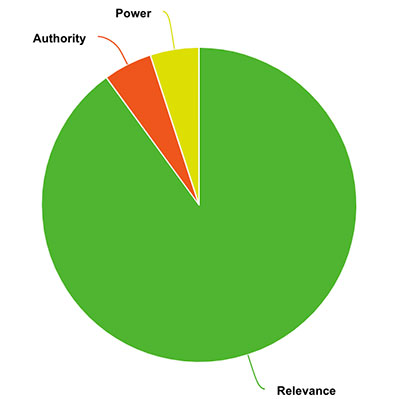
Likewise, a link can be high on authority but low on relevance and power.
But this link can still provide tremendous benefit for your rankings in the Google search results.
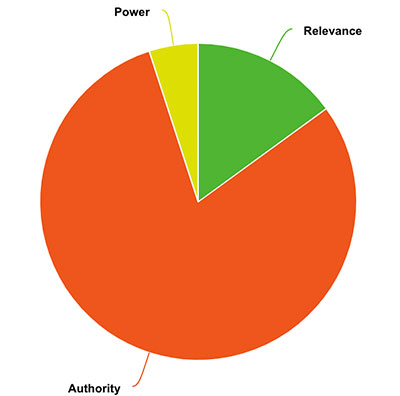
You can think of these things on a sliding scale.
The less of one attribute the backlink has, the more of the other factors you want it to have.
In a perfect world, all of your links would have high amounts of all three factors.
But that just isn’t possible (or natural).
Natural sites get backlinks with wide discrepancies in the Holy Trinity spectrum, and most of these links play active roles in helping the sites rank in search engines.
When you want to build high quality backlinks, there are more factors to consider other than the Holy Trinity spectrum of link attributes.
However, the Holy Trinity is a simple and reliable analytical framework to simplify your link building decisions and help you make quick judgments.
Before we jump into other factors besides these to gauge link quality, let’s first go a little deeper into the Holy Trinity of relevance, authority, and power.
Relevance
We’ve got a whole article on backlink relevance along with a video walkthrough for those that really want to get into it, but we’ll go ahead and summarize it here as well.
A link is relevant for your website if the domain, content, and on-page factors are related to whatever it is linking to.
Relevance can be checked with a tool like Ahrefs or with your eyes.
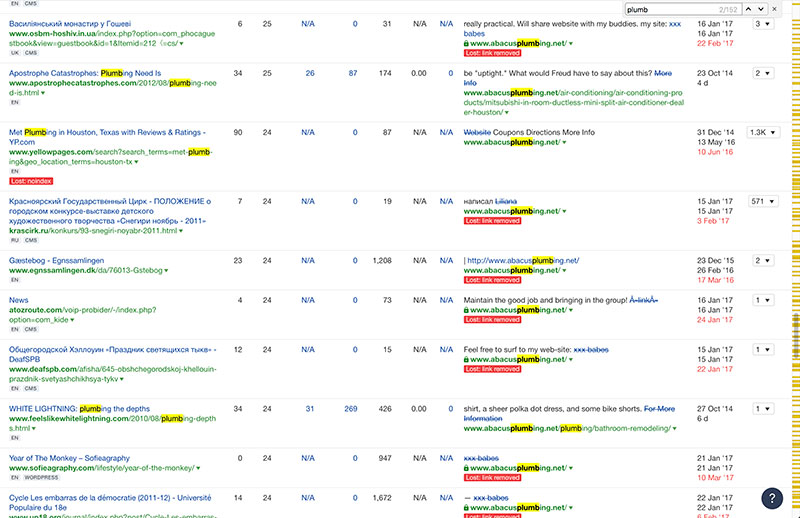
In other words, if there are keywords or related keywords in the linking page’s domain, URL, SEO title, meta description, h tags, content, and anchor text which are the same as or related to what it’s linking to, it becomes more relevant for what it’s linking to.
For example, if a page that is well optimized for plumbing links to a local plumber’s website, this is a very relevant backlink for that website.
But that doesn’t mean the whole linking domain needs to be about plumbing.
In the real world, there are many tangentially related niches that can make sense to link to a site in the plumbing niche.
You can ask ChatGPT for a list of related niches that would make sense to link to your website if you need more help.
This is probably the biggest mistake we see beginner SEOs making: They think that only hyper-relevant backlinks are relevant.
There are four levels of relevance, and all of them can occur naturally in the real world:
- Domain-level relevance
- Article-level relevance
- Paragraph-level relevance
- Sentence-level relevance
In most cases, we aim for domain-level and article-level relevance when building links ourselves.
But links that only have paragraph-level or sentence-level relevance might be possible when building niche edits, and that’s just fine.
Just make sure you get a mix of these types!
Authority
The second link attribute of the Holy Trinity that makes a high quality backlink is its authority.
A little less clear than relevance, authority is generally determined by the overall strength of a domain’s backlink profile (i.e. its composition of referring domains) and other obscure factors like Trust.
An example of extremely authoritative outgoing links is those coming from a widely respected and trusted news source such as CNN.
CNN is high in both backlink authority and trust with Google.
Some of the most valuable links one can acquire are editorial backlinks from giant news publication sites, even though these domains are technically low on relevance as they are very “general” sites.
You can see that CNN has a massive number of referring domains, and you can bet a good proportion of them are authoritative in their own right.
This is why CNN is viewed as a very reliable source of high-quality content by Google (and the search engine results page reflects that view in CNN’s favor).

You can use an SEO tool for backlinks analysis, such as Ahrefs, to apply a relevant metric in your assessment of a domain’s authority.
Specifically, an Ahrefs metric called Domain Rating (DR).
In the picture above, you can see that CNN has a very high DR (and also an insane amount of backlinks).
You can check authority with other services like Moz’s DA, Majestic’s CF/TF, and so on.
Although none of these provide a perfect picture of websites’ authority, we generally stick with Ahrefs’ DR to make judgments as it seems more accurate and more difficult for SEOs to manipulate.
Just like the previous section, a high authority link that’s low on power and relevance can be great for you, just as a backlink that’s low on authority but higher on relevance and power can be.
Remember to think about the Holy Trinity on a sliding scale.
Power
Power is the most straightforward of the three backlink quality factors that comprise the Holy Trinity.
Simply put, a backlink’s power is determined by the amount and quality of the incoming links of the page with the link on it.
In other words, the power of individual backlinks on individual web pages is related to the strength of each page’s backlink profile.
Power is noted by URL Rating (UR) on Ahrefs and by PA (Page Authority) on Moz.
If an article with 300 backlinks points to your target with a backlink, you can expect the backlink to be pretty powerful.
However, note that many of the backlinks you get will not have any backlinks pointing to the linking page.
This is completely normal with things like guest posts, as links are coming from brand-new articles that haven’t had a chance to get any of their own backlinks yet.
Moreover, a backlink that’s low on power, but high on authority/relevance, can still be a quality backlink.
Just make sure you’re not getting only low-power links, low-authority links, or low-relevance links.
Just remember that it is completely natural to get a mix of links that are both high and low on power, and they can all greatly benefit your site’s authority and rankings.
Traffic and Rankings
Two related link building metrics we need to address are traffic and rankings.
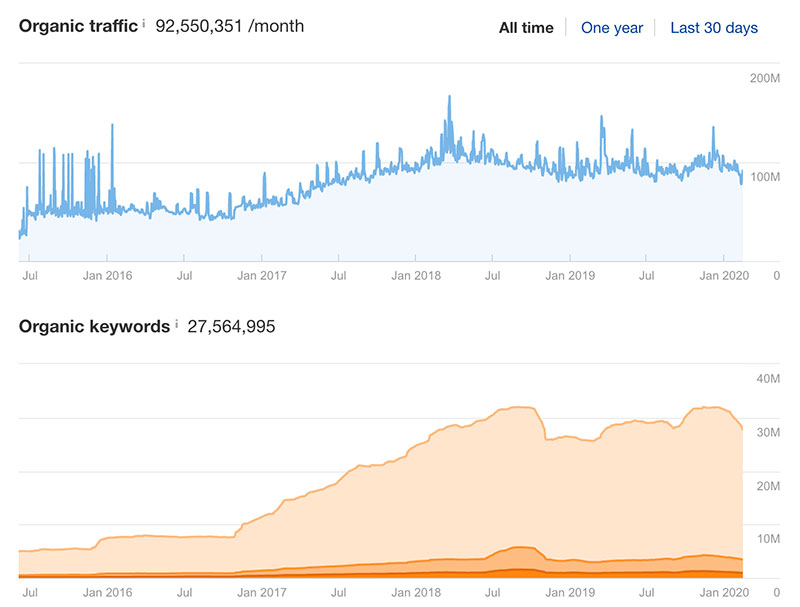
You can pull these metrics up for any website using a tool like Ahrefs or Google Analytics.
If a linking site has a good amount of traffic or ranks well for a lot of keywords, then you can safely assume that it may be quite beneficial for your rankings.
These two metrics don’t seem to be quite as important as power, relevance, and authority, but they are a good way to determine if Google trusts the site (which is also very important!).
A good example of a backlink that usually doesn’t have any traffic or search results rankings would be a PBN link.
Although we don’t use PBN links as much as we did in the past, we also can’t deny that they still work well when used safely and intelligently.
If you have the choice between two links with equal metrics, and one of them has a decent amount of traffic/rankings while the other doesn’t…
The one with decent metrics is probably better!
But don’t write off a backlink just because it’s low on traffic and rankings.
Nor should you base all of your judgment on a backlink’s quality on traffic and rankings alone.
These metrics are as easy to game as authority, so further inspection is always necessary using your favorite SEO tool.
Types of Quality Backlinks
Besides the idea of different types of links being useful due to the concept of link diversity, many outgoing links also have unique purposes in the hands of a skilled SEO.
Broadly speaking, you can categorize most backlinks as either pillow links (foundational links) or editorial links.
Both types are highly useful.
Editorial links are high quality backlinks that are harder to acquire (and more expensive) than pillow links that come from real websites with blog sections.
On the other hand, pillow links are typically free and easy to build yourself.
But that does not mean pillow links are low quality backlinks.
We consider pillow links to be quality links in their own right, and some of the most important links any website can have (especially at the beginning of a link building campaign).
Pillow links are essential tools to utilize when building links to create a natural link building foundation and add important link diversity to your link profile.
Pillow links include links such as:
- Web 2.0s (user-generated content)
- Citations
- Blog post comments
- Social profiles
- Press releases
- And many more
Citations are a very natural type of pillow link that builds trust and adds location relevance. These links won’t push you to the top positions, but they are still very important.
Editorial links are links such as:
- Niche edits (link insertions)
- Guest posts
- HARO
- Digital PR
- PBN links
These are the powerful ranking tools that do most of the heavy lifting for websites trying to improve their SERP positions.
Each type of high quality backlink is slightly different and extremely useful.
For a more detailed explanation of backlink types and their uses, check out our article on backlink diversity.
Anchor Text
Anchor text is the clickable text of the link itself.
This is another important component of backlinks, which we’ve already discussed briefly in the relevance section.
In the past, SEOs tended to overuse keywords within anchor text to jump straight to the top positions.
Now, this type of manipulative link building can land your website in some serious trouble.
Having said that, you still want to use some exact match and partial match anchors, but a link can still be a high-quality backlink if it has non-keyword anchors.
Examples of natural anchor text are:
- Branded anchors
- URL (naked) anchors
- Generic anchors
- Long-tail anchors
- Topical anchors
Just like you need to diversify your backlink profile, you also need to diversify your anchor text profile.
A link with keyword-rich anchor text might do more pushing for your rankings, but you can’t solely use keyword anchors and expect to succeed in the modern era of search engine optimization.
At our link building agency, this is probably the number one thing we see people getting themselves in trouble with with performing backlink audits for our Managed Link Building service.
People think that if they are spending a lot of time and money on backlinks, they should use exact match anchors to get the most bang for their buck.
Wrong!
You’ll be much better served in the long term with a more natural and less aggressive approach to anchor text.
Contextual Backlinks
A contextual link is a backlink that exists within a paragraph of information.
In other words, it’s surrounded by contextual content (which attributes topical relevance to the link).
All of the links you see in this article with the orange text are contextual.
Contextual links are more sought after than non-contextual links because they help to build relevance.
But like we discussed before, high quality links don’t necessarily have to be highly relevant to be useful/valuable.
Links such as sidebar links and footer links can still pass tons of juice if they are on authoritative, powerful pages.
However, we highly recommend not basing your link building strategy off using these types of links as they were highly abused in the past.
A small amount would be OK.

You don’t want mostly footer and sidebar links as that would be very unnatural, but that doesn’t mean they are low-quality links.
Indexation and Crawlers
In general, you want your links to be on pages that are indexed by Google.
You can check for indexation by using the “site:” search operator.
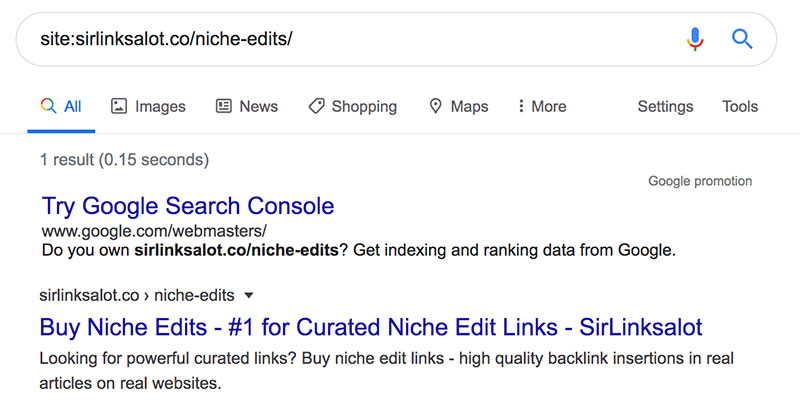
If you just got a guest post link from a new article, it might take some time for Google to index it (based on the size/authority of the linking site).
You will want to make sure that all of your editorial links eventually get indexed.
Some types of pillow links might take forever to index or not index at all.
We usually don’t worry too much about pillow links not indexing, as Google realizes that most searchers don’t want to see something like a citation in the SERPs.
There is evidence that shows that Google still knows about such a link even though it isn’t visible in the search engine index.
Aside from Google’s index, many SEOs place too much weight on a backlink’s quality by how quickly/if it shows up in Ahrefs or similar tools.
You have to remember that Ahrefs is an imperfect crawler, and it takes serious time to crawl the entire internet.
It might take Ahrefs a lot longer to add a link to its index than Google, and sometimes, it won’t even add it at all.
Remember that Google’s algorithm (and its search engine crawlers) are the most important entities that evaluate backlinks – not Ahrefs, Moz, website owners, Internet marketing gurus, or anyone else.
See our Ahrefs guide for more information on how we like to use this powerful tool for analyzing sites and searching for link building opportunities.
Spam
Unless you are a veteran SEO who understands the risks involved, you probably don’t want to mess around with spammy links or spammy sites.
That being said, there is a lot of misunderstanding on this topic.
Here are some different things that some SEOs consider spam:
Visually Outdated/Untrustworthy-Looking Sites
Google web crawlers and other search engine bots do not know what “trustworthy” looks like in an aesthetic sense (or what good design looks like).
Disregard these factors when determining the quality of a backlink in most cases.
High Amounts of Outbound Links from the Linking Page
This can actually matter, however the number of outbound links a linking page can safely have without completely diminishing the value of your link is not known.
Got a link on a page with 500 outbound links?
Probably not too good.
That sounds like something spammy websites would do (especially if they are all pointing to a specific page).
Auto-Generated Links
Stay away from these unless you’re a black-hat pro.
Getting tons of links with keyword-rich anchors with slight variations in anchors, URLs, etc can be highly damaging to rankings and link profiles.
Spun Content
Links from spun or extremely low quality content are not a good thing.
You won’t always have problems, but it definitely increases the chances of being penalized by Google’s algorithm.
Think you’ve got some spammy links from a shady website that you want to get rid of?
You might want to consider a disavow.
However, use this as a last-case scenario and only if you are sure the links in question are actually spam and that they are actually having a negative impact on your site’s rank.
If you are not a professional, we recommend hiring one so you don’t end up doing more damage than good with your disavow.
White-Hat, Gray-Hat, Black-Hat
Google does not know the difference between a white-hat link and a black-hat link if you are following industry best practices and safe link building techniques.
Of course, there is more room for user error when building gray-hat and black-hat links, and the inexperienced or uninformed can land themselves in trouble in the form of penalties – algorithmic or manual.
But in the hands of a skilled SEO, that “hat” of a backlink has zero effect on its quality.
That being said, we highly recommend sticking with the safer link types when you are just getting started.
Do-Follow vs. No-Follow
In general, you will want your editorial links to be dofollow links, but that’s not always possible.
There is evidence provided by recent case studies that nofollow links can still pass significant link juice as Google now sees this tag merely as a suggestion.
Additionally, many foundational or pillow links will be nofollow, and that’s just fine.
Price
In a perfect world, high quality links would always be more expensive and low-quality links would be cheaper.
In the real world, this isn’t so much the case.
While you can generally safely assume that dirt-cheap backlinks are too good to be true, it doesn’t always work the same way in the other direction.
Higher prices do not always mean higher quality when you are buying links.
This is because link vendors do not always have control over the pricing for the site your link is placed on.
Prices for a high quality backlink, such as Guest Post, are set by the site owners.
Conclusion
In this comprehensive guide, we’ve explored what constitutes a quality backlink for SEO.
From understanding the fundamental attributes of relevance, authority, and power, collectively known as the Holy Trinity, to diving into various types of backlinks and their specific functions, it’s clear that successful link building requires a nuanced approach.
Whether you’re integrating pillow links to lay a solid foundation or securing editorial links for substantial ranking boosts, the key lies in maintaining a balanced and diverse backlink profile.
Additionally, we touched on the importance of contextual relevance and the right mix of anchor text to ensure that links not only improve your SEO stature but do so in a manner that aligns with Google’s evolving algorithms.
Remember, the ultimate goal is to enhance your site’s authority and rankings organically.
Quality backlinks are not just about sheer numbers; they’re about strategic placements and making every link count toward your overall SEO objectives.
Staying informed and adaptable to the changes in search engine algorithms will be crucial.
Remember, a well-crafted link building strategy is not just an option, it’s a necessity.
 Article by:
Article by:
Chris Tzitzis
Hey I'm Chris, one of the founders here at SirLinksalot. I'm into building internet money machines (affiliate websites) and specialize in building backlinks. Find out more about me and my link building team.
 Questions or Comments?
Questions or Comments?
We are active in our Facebook Group seven days a week and would love to hear from you. Ask us questions, learn from other group members, and share your knowledge.
Related Posts
Ready To Start Building Your Rankings?
Your link building journey to the top of Google starts today!
Apply for Managed Link Building to get a free analysis and game plan, or order backlinks a la carte.
Link building services that work.


